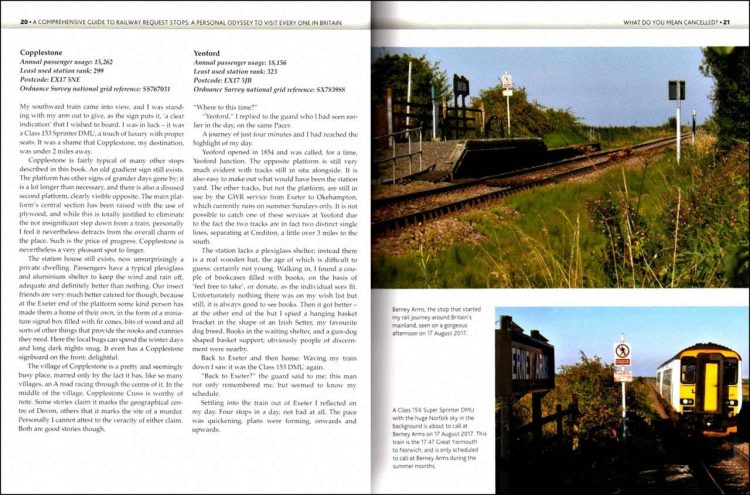Published in November 2021, this book from publishers Pen & Sword, and written by Anthony Hart, describes the author's quest to visit, photograph, and spend time at every request stop on mainland Britain.
The book is hardback and measures around 27.9 cm x 21.6 cm, has 208 pages and 200 colour illustrations. It has a published price of £30, although at the time of writing it can be obtained online from Amazon for £23.59.
There are some books that, as soon as you read the first page, you know you are in for a treat. This is one such book that simply oozes nostalgia and pleasure from every page. Local knowledge is interspersed with good servings of humour, such as to get off at Denton and find out that the next train does not leave for another week.
The photographs show that Britain's stations have not been given over to soulless waiting shelters, but there are many that still hark back to the time when the railways really were a public service. Little touches, such as well-tended flower beds at stations served by just a handful of services each week add to their attraction.
However, in some cases, the dreaded Health and Safety tried to thwart the author's efforts, such as at Chetnole between Yeovil and Weymouth where the guard wouldn't let him off the train because he was on the wrong type of train. In this case, he was on a three-car Class 166 Thames Turbo, which didn't have selective opening of the doors, so even though he was obviously the only person wishing to alight, the guard wouldn't open the doors in case an invisible person fell out onto the line. He overcame the problem by staying on the train, getting off at the next stop and returning by the following train, a Class 150, that did have the necessary selective door opening.
The station at top-left below is Berney Arms in Norfolk where the Author's odyssey began. It is also England's most-remote station, as it has no vehicular access and anyone who misses the last train faces a walk of at least three miles to the nearest road.

The top-left photo below is Chetnole, where because of the wrong type of train, the guard would not let the author alight, which meant he had to travel to the next station along the line and travel back on the right type of train.
The stations shown below are on the Liskeard to Looe branch line and are typical of many request stops, where the facilities have not been destroyed in the drive for standard anonymous bus stop-type waiting shelters. The station at bottom-right also has the fascinating name of St. Keyne Wishing Well Halt, which lives up to its name with a wishing well just a ten-minute walk away.
The author's humour shines through in his title for Chapter 6. Instead of a simple “Llanelli to Shrewsbury” or “Heart of Wales Line”, he has opted for the more figurative “Repeat After Me, Cynghordy”. The station on the left is the isolated station of Sugar Loaf, and like so many of the stations and halts along this line, its appearance is a credit to whoever looks after them.
Although the stations shown below, which are on the Stockport to Stalybridge line, give the indication of being used by a frequent service, their facilities are way over the top for stations that see just one passenger service a week. With the author sticking by his ethos of actually getting off at the station, if he were to wait until his next train came along he would have had to wait over 167 hours.
Unusual on Britain's railway is Dunrobin Castle shown on the left below, which is privately-owned by the Duke of Sutherland, At one time the public could not use, it, but since 1985 it has been available as a request stop on the line between Inverness and Wick and Thurso, but only during the summer months when the nearby castle is open to visitors. Contrasting views of Kildonan on the same line are shown on the right, where basic facilities are supplemented by a set of steps on the edge of the platform should anyone wish to board or alight from the next train. At one time, the station had two platforms, and the lower photo shows the second platform's antiquated waiting shelter which still exists.
In summary, this is not just a tour around all of Britain's request stops, but also shows the pleasure one can get from visiting unfamiliar and often very remote places, taking us to the more off-the-beaten-track places of our railway system. From beginning to end, the book is a joy to read, combining historical details with subtle humour throughout, and anyone with the slightest interest in railway heritage will love it. I hope this wonderful book can be re-published in a pocket-size handbook for anyone who wishes to follow in the author's footsteps. Very highly recommended.
The book is available to purchase from Amazon and from Pen & Sword.
We would like to thank Pen & Sword for providing RailAdvent with a copy of the book for review.